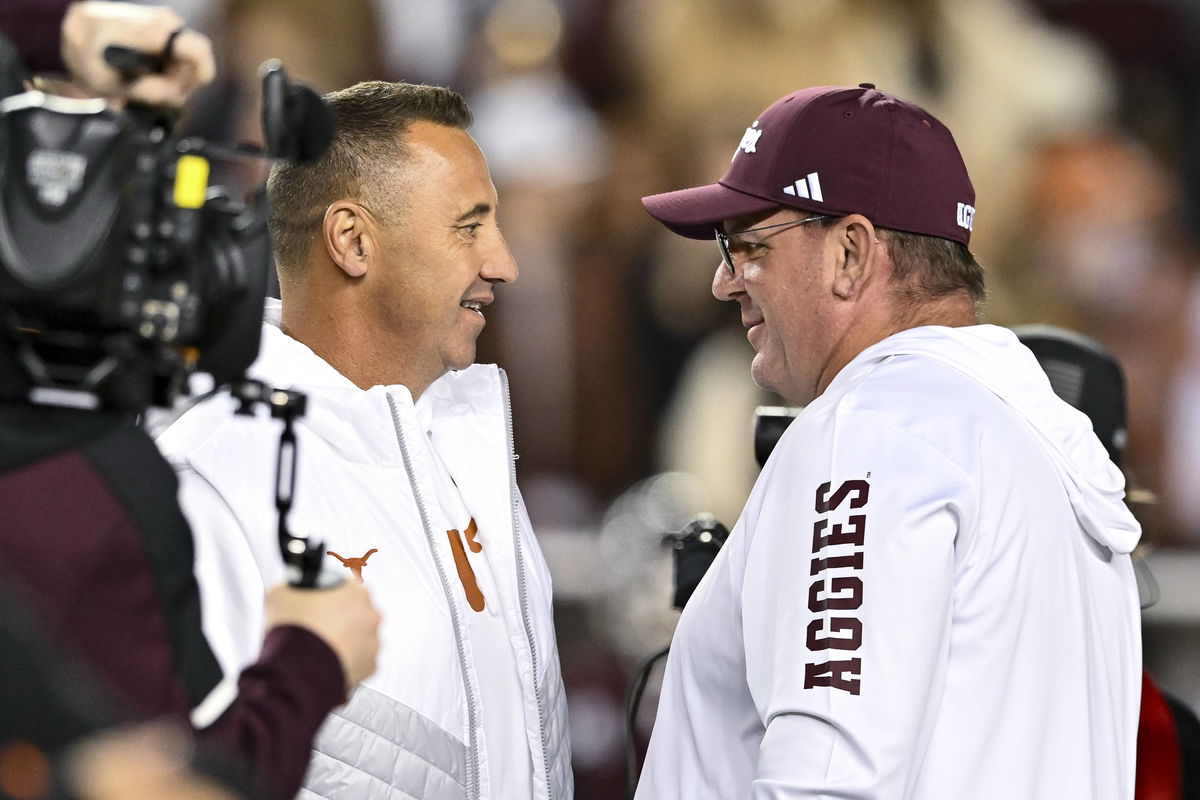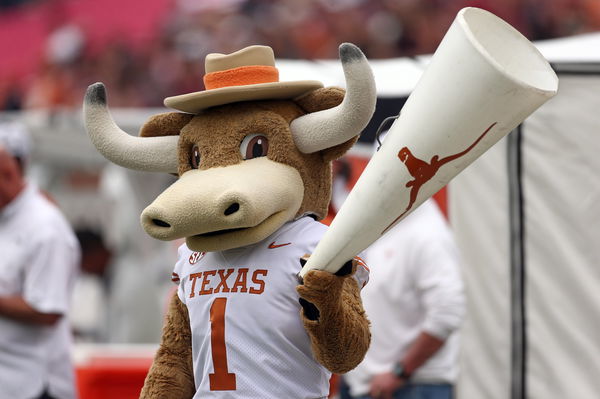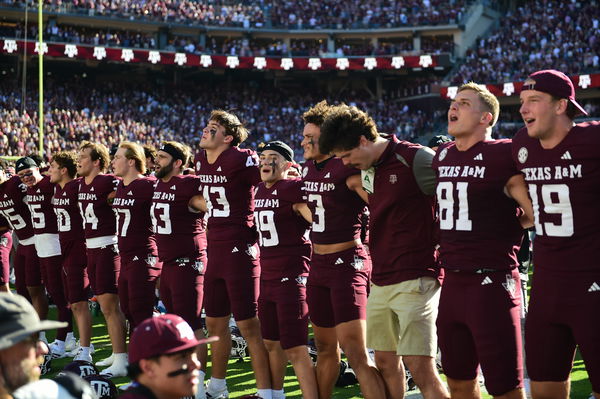
Imago
NCAA, College League, USA Football: Texas at Texas A&M Nov 30, 2024 College Station, Texas, USA Texas Longhorns head coach Steve Sarkisian, left, and Texas A&M Aggies head coach Mike Elko, right, speak prior to the game at Kyle Field. College Station Kyle Field Texas USA, EDITORIAL USE ONLY PUBLICATIONxINxGERxSUIxAUTxONLY Copyright: xMariaxLysakerx 20241130_mcl_la6_004

Imago
NCAA, College League, USA Football: Texas at Texas A&M Nov 30, 2024 College Station, Texas, USA Texas Longhorns head coach Steve Sarkisian, left, and Texas A&M Aggies head coach Mike Elko, right, speak prior to the game at Kyle Field. College Station Kyle Field Texas USA, EDITORIAL USE ONLY PUBLICATIONxINxGERxSUIxAUTxONLY Copyright: xMariaxLysakerx 20241130_mcl_la6_004
The final week of the CFB regular season will feature numerous in-state games, including the Texas vs. Texas A&M clash. Darrel K Royal Stadium will host the November 28 clash for the second time since the teams renewed their rivalry last year after a 13-year hiatus. The Aggies come into the matchup undefeated at 11-0, riding a high-powered offense ranked second nationally.
Watch What’s Trending Now!
Texas, ranked 16th, brings a resilient but inconsistent team. The Longhorns rely on efficient defense and field position, but have struggled with penalties and rushing success. Those who won’t be able to attend the stadium can watch it on ABC, where Sean McDonough and Greg McElroy will provide commentary. However, before you set a reminder, here are three interesting facts about this historical rivalry.
ADVERTISEMENT
When did the Texas-Texas A&M rivalry begin?
It all kicked off on October 19, 1894, when Texas ruthlessly dominated the Aggies with a 38-0 win in Austin. Texas won the first eight games straight, and the Aggies didn’t put a single point on the board until their ninth clash. But the story didn’t stay one-sided for long. As the early 1900s rolled on, A&M began to flip the script. Things got even spicier when Texas refused to play from 1911 to 1915, accusing A&M of being “too dirty.” Ironically, during that hiatus, A&M dominated with three straight wins, outscoring Texas 42-8.
Texas vs Texas A&M tribute video. A battle of the rich kids. (Sound on) pic.twitter.com/Gp1sEGIMh7
— John Daniels 🔥 (@jdanielssports) November 25, 2025
After both teams joined the Southwest Conference in 1915, it became a tradition to play on Thanksgiving. Families gathered around to watch the Lone Star showdown. Both the rivals exited the SWC in 1996 to join the newly formed Big 12 conference. However, after 16 years, the Aggies moved to the Southeastern Conference, and the Longhorns followed 12 years later.
ADVERTISEMENT
Story of the Texas mascot Bevo
One of the most legendary parts of this rivalry? Bevo, Texas’s iconic mascot. People recognize the Texas longhorn steer for its iconic horns, stretching about 8 feet from tip to tip, and for its attention-grabbing presence on the sidelines of Longhorns football games. The university began the tradition of using a live longhorn mascot in 1916. It was when an alumnus brought one out during a Thanksgiving Day victory over Texas A&M. After A&M won 13-0 in 1915, a group of Aggies snuck in and branded “13-0” on a steer’s side as a taunt to Texas. The Longhorns cleverly turned that branding into the letters B-E-V-O.
ADVERTISEMENT

ADVERTISEMENT
But this tall tale doesn’t hold up. Over the years, Bevo has built a reputation as an ornery and unpredictable mascot. Bevo XV, the current mascot, got popular for surging from its pen during the 2019 Sugar Bowl, startling a photographer and sparking viral videos. Earlier Bevos were rumored to cause chaos as well. Stories like Bevo II charging an SMU cheerleader or Bevo III roaming free for two days add to the mythical personality of the mascot.
The lyrical loathing doesn’t take a backseat
Both teams have left no stone unturned to sledge each other. They haven’t even left their war songs to portray hate for each other. Picture this: It’s 1918, World War I trenches in France, and Aggie J.V. “Pinky” Wilson scribbles the original “Aggie War Hymn” on the back of a letter home. He dubs it “Goodbye to Texas University,” a straight-up diss to their hated rivals. The second verse? Pure fire. “Goodbye to Texas University, So long to the orange and the white… ‘The eyes of Texas are upon you.’ That is the song they sing so well.” Aggies belt it out twice, fans yelling “sounds like hell!” after mocking UT’s anthem, then sway arm-in-arm, sawing “Varsity’s horns off!”
ADVERTISEMENT

Even after a 1938 tweak to tone down the UT hate with a first verse praising A&M, students stuck to the original twice. However, the other side is no less. Back in the roaring rivalry days around 1909, Texas alum Walter S. Hunnicut was fed up with the Aggies’ taunts. Their powerhouse “Farmers Fight” song mocked “The Eyes of Texas,” hitting Longhorn pride where it hurt. So Hunnicutt fired back. He penned the original “Texas Fight” to the tune of “Taps” with band director James E. King, later polished by Blondie Pharr. And, oh boy, the lyrics!
“Texas Fight, Texas Fight, And it’s goodbye to A&M… Texas Fight, Texas Fight, And we’ll put over one more win.” Aggies get roasted as the enemy to crush, with fans swapping “Hail, Hail, the gang’s all here” for a rowdy “Give ’em hell, Give ’em hell, Go Horns Go!” before belting “Yea Texas Fight!” twice. This 1917-ish banger blasts after every touchdown, fueling a century of Lone Star trash talk. However, the 2025 offseason showcased a somewhat humiliating moment for the Longhorns and their current coach, Steve Sarkisian.
During the SEC media days, Steve Sarkisian strides toward the podium after shaking hands with commissioner Greg Sankey. Suddenly, the speakers blast the Aggie War Hymn instead of “Texas Fight.” Imagine the utter chaos at that point. Sark, ever the pro, doesn’t flinch, diving straight into remarks on Central Texas floods and QB Arch Manning’s role without spotlighting the gaffe. Aggie fans online erupted in glee, dubbing it a savage troll on the hated rivals. The ‘music guy’ redeemed it by blasting “Texas Fight” at the end,
ADVERTISEMENT
ADVERTISEMENT
ADVERTISEMENT

